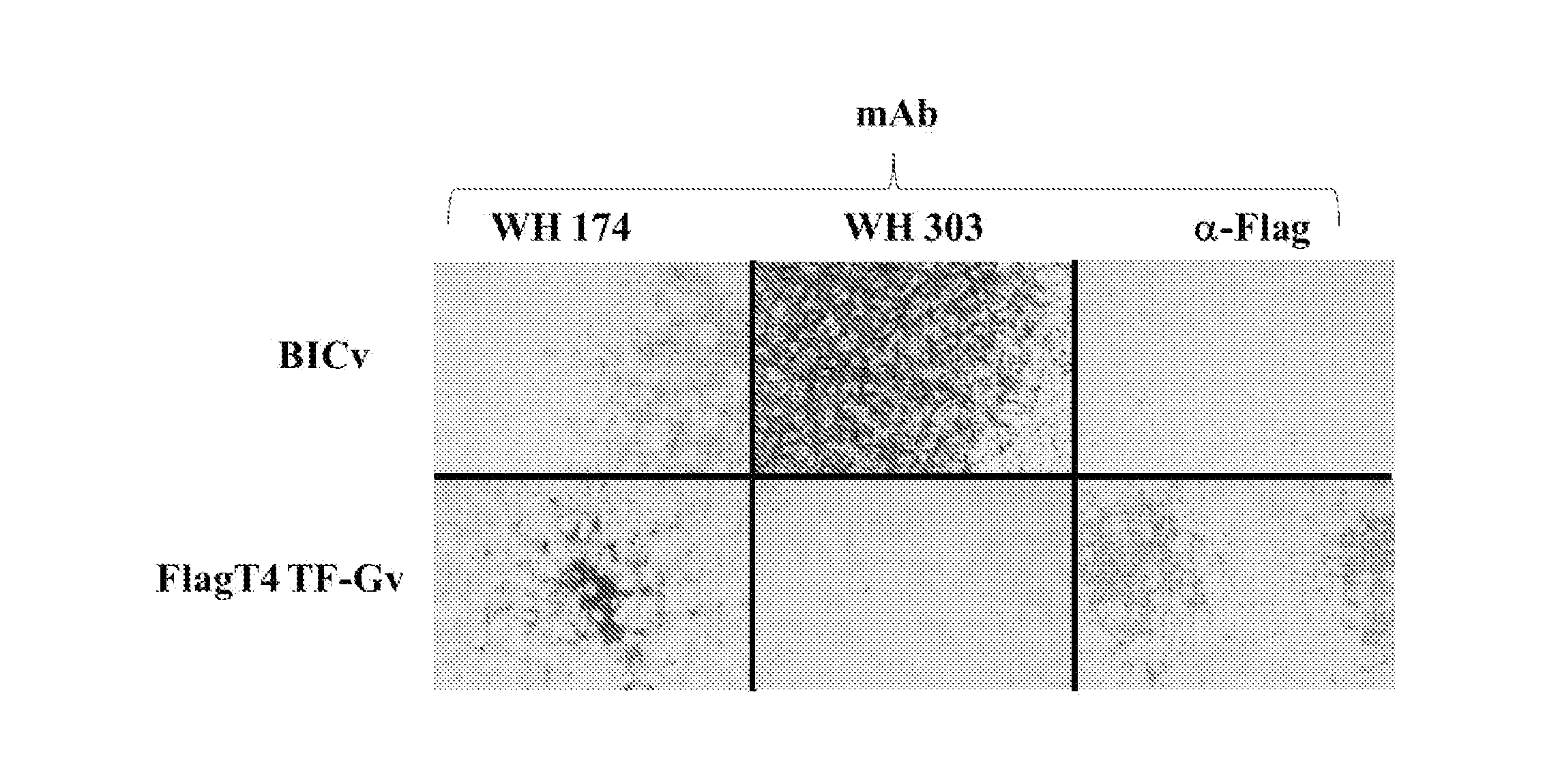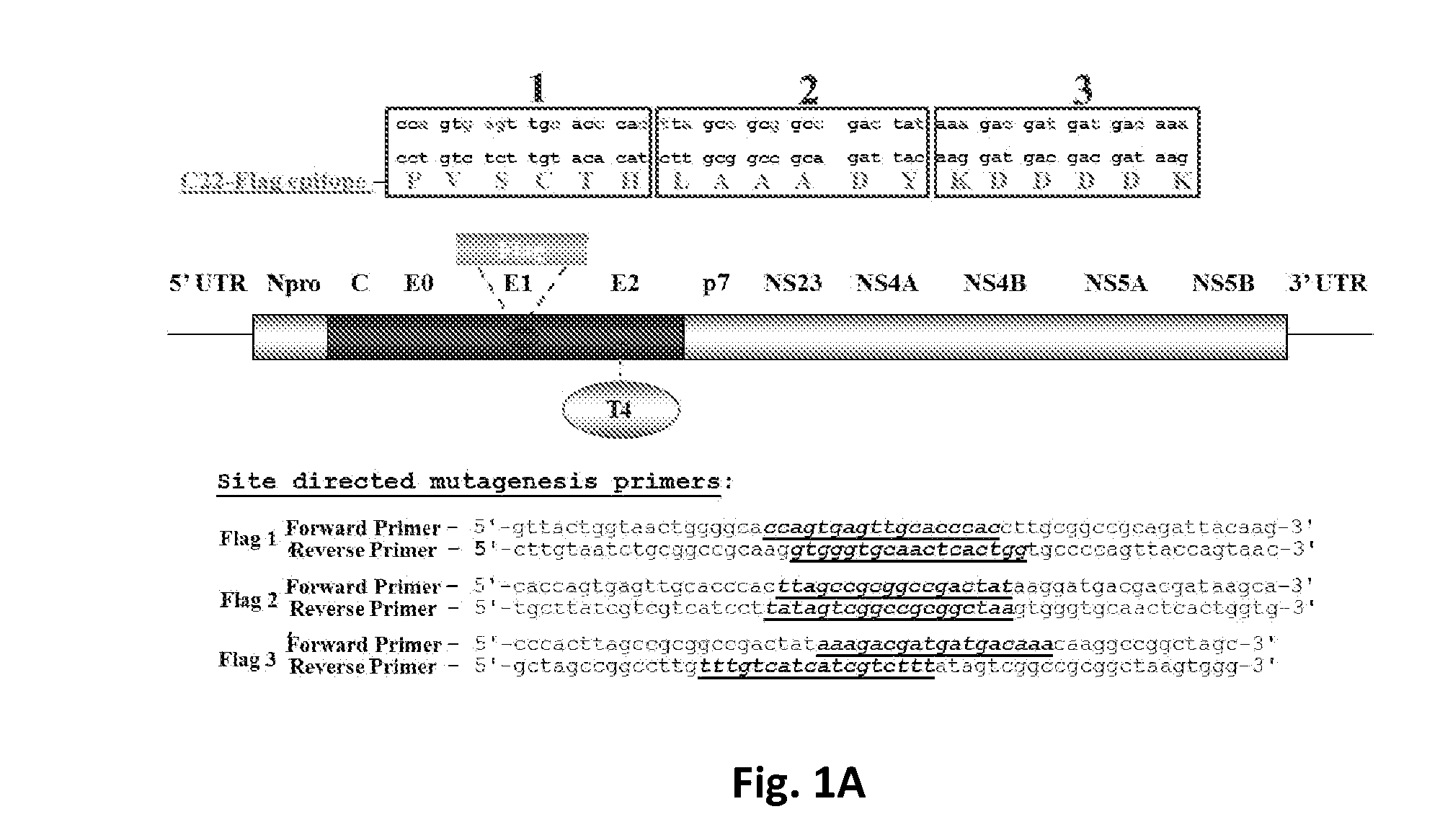Live Attenuated Antigenically Marked Classical Swine Fever Vaccine
a live attenuated virus and antigen-marking technology, applied in the field of double antigen-marking classical swine fever virus, can solve the problems of limiting the efficacy of live attenuated virus vaccines relative to traditional live attenuated virus vaccines, and affecting the use of csfv live attenuated virus
- Summary
- Abstract
- Description
- Claims
- Application Information
AI Technical Summary
Benefits of technology
Problems solved by technology
Method used
Image
Examples
example 1
Viruses and Cell Cultures
[0048]Swine kidney cells (SK6) (Terpstra et al. 1990. Dtsch. Tierarztl. Wochenschr. 97: 77-79), free of BVDV, were cultured in Dulbecco′ minimal essential medium (DMEM) (Gibco, Grand Island, N.Y.) with 10% fetal calf serum (FCS) (Atlas Biologicals, Fort Collins, Colo.). CSFV derived from full-length cDNA copies, including CSFV Brescia strain (BICv) (Risatti et al. 2005a. J. Virol. 79: 3787-3796), RB-C22v (Risatti et al. 2005b. Virology 343: 116-127), T4v (Risatti et al. 2006. Virology 355: 94-101), and FlagT4v (Holinka et al., supra) were propagated in SK6 cells. Titration of CSFV from clinical samples was performed using SK6 cells in 96 well plates (Costar, Cambridge, Mass.). Viral infectivity was detected, after 4 days in culture, by immunoperoxidase assay using the CSFV monoclonal antibody (mAb) WH174 (kindly provided by Georgina Ibata, Veterinary Laboratory Agency, UK) or mAb WH303 (Edwards et al., supra), and the Vectastain ABC kit (Vector Laboratories,...
example 2
DNA Sequencing and Analysis
[0049]Full-length infectious clones and in vitro rescued viruses were completely sequenced with CSFV-specific primers by the dideoxynucleotide chain-termination method (Sanger et al. 1977. Proc. Natl. Acad. Sci. USA 74: 5463-5467). Sequencing reactions were prepared with the Dye Terminator Cycle Sequencing Kit (Applied Biosystems, Foster City, Calif.). Reaction products were sequenced on a PRISM 3730xl automated DNA Sequencer (Applied Biosystems). Sequence data were assembled with the Phrap software program (Retrieved from the Internet: phrap.org), with confirmatory assemblies performed using CAP3 (Huang and Madan. 1999. Genome Res. 9: 868-877). The final DNA consensus sequence represented, on average, five-fold redundancy at each base position. Sequence comparisons were conducted using BioEdit software (Retrieved from the Internet: mbio.ncsu.edu / BioEdit / bioedit.html).
example 3
Development of FlagT4-mFT-Gv
[0050]Infectious clone (IC) encoding for the FlagT4-mFT-Gv was designed and developed by modification of the FlagT4v infectious clone. Basically, the Flag area, i.e., the Flag / modified 20 mer insertion of FlagT4v infectious clone, was modified in three different progressive steps (Blocks 1, 2, 3 of FIG. 1A) by site-directed mutagenesis using the primers depicted in FIG. 1A. The site-directed mutagenesis resulted in the new mutant virus FlagT4-mFT-Gv having the identical amino acid sequence as the parent FlagT4v infectious clone virus; however, the codons used to encode the identical amino acids of the mutant virus FlagT4-mFT-Gv were changed (mutated) as compared to the parental virus (FlagT4) as shown in FIG. 1A. Similarly, changes in codon usage were also introduced in the T4 area by a single site-directed mutagenesis step as shown in FIG. 1B. In addition, an amino acid substitution was also included, that is, Asparagine was replaced by Glycine, at posit...
PUM
| Property | Measurement | Unit |
|---|---|---|
| hydrophobic | aaaaa | aaaaa |
| attenuation stability | aaaaa | aaaaa |
| color | aaaaa | aaaaa |
Abstract
Description
Claims
Application Information
 Login to View More
Login to View More - R&D
- Intellectual Property
- Life Sciences
- Materials
- Tech Scout
- Unparalleled Data Quality
- Higher Quality Content
- 60% Fewer Hallucinations
Browse by: Latest US Patents, China's latest patents, Technical Efficacy Thesaurus, Application Domain, Technology Topic, Popular Technical Reports.
© 2025 PatSnap. All rights reserved.Legal|Privacy policy|Modern Slavery Act Transparency Statement|Sitemap|About US| Contact US: help@patsnap.com



